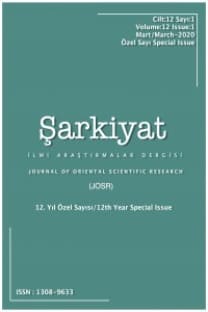ALKAME KISSASI İLE HÂTÛN DESTÂNI ARASINDA KARŞILAŞTIRMALI BİR DEĞERLENDİRME
Türk edebiyatında geçmiş yüzyıllarda yaşanmış bazı olaylar konu alınarak çeşitli eserler yazılmıştır. Hâtûn Destânı bunlardan bir tanesidir. Eser manzum hikâye tarzında eski Anadolu Türkçesiyle kaleme alınmıştır. Hâtûn Destânı’nın birden fazla nüshası olup tespit edilen nüshalar günümüz Türkçesine çevrilmiştir.
Hâtûn Destânı’nda Hz. Peygamber zamanında yaşamış Oğlan diye tanıtılan bir şahsın ve annesinin başından geçenler anlatılmaktadır. Bu hikâyenin, konusunu Alkame kıssasından aldığı düşünülmektedir.
Çalışmada Hâtûn Destânı ile Alkame Kıssası metin bakımından ele alınmış, roman ve hikâyede kullanılan değerlendirme ölçütleri kullanılarak karşılaştırılmıştır. Her iki metin olay örgüsü, şahıs kadrosu, zaman, mekân, dil ve anlatım ile ana düşünce bakımından ele alınmıştır. Karşılaştırma esnasında manzum hikâye ve kıssa arasında metin türü bakımından teknik bir değerlendirme de yapılmıştır.
Bu çalışmada amaç Hâtûn Destânı’nın hangi gerçek olaya dayandığını ortaya koymaktır. Ayrıca Alkame Kıssası’nın kurgulama sonucunda manzum hikâyede ne kadar değişikliğe uğradığını ortaya çıkarmak ve manzum hikâye ile kıssanın metin türü bakımından karşılaştırılmalı teknik bir değerlendirmesini yapmak diğer amaçlarımızdır.
Anahtar Kelimeler:
Hatun Destanı, manzum hikaye, Oğlan, Anne, metin
A COMPARATIVE EVALUATION BETWEEN ALKAME'S PARABLE AND HÂTÛN’S EPOS
Various works have been written by taking into account some events that happened in the past centuries in Turkish literature. Hâtûn’s Epos is one of them. The work was written in the style of a poetic story in old Anatolian Turkish.
It describes what happened to a person who was introduced as the Boy who lived in the time of the Prophet and his mother. It is thought that this story takes its subject from the parable of Alkame. Since Hâtûn’s Epos is a fictional text, the imagination of the narrator has been mixed into the text.
In the study, Hâtûn’s Epos and the parable of Alkame were compared using the evaluation criteria used in the novel and the story. Both texts are discussed in terms of plot, personal staff, time, place, language and narration, and main idea. During the comparison, a technical evaluation was made between verse story and parable in terms of text type.
The purpose of this study is to reveal which real event the Hâtûn’s Epos is based on. Our other aims are to make a comparative technical evaluation of the story of allegation in terms of the extent of the change in verse story as a result of the editing and the text type of the verse story and the story.
Keywords:
Hâtûn’s Epos, epos, Boy, Mother, text.,
___
- Ahmed b. Hanbel. Müsned, nşr. Müessesetu’r-Risâle. c. 32. Beyrut: 2001.
- Aktaş, Şerif. “Edebî Metin ve Özellikleri”. Atatürk Üniversitesi Türkiyat Araştırmaları Enstitüsü Dergisi S. 39 (2009), 187-200.
- Argunşah, Mustafa. Kirdeci Ali Kesikbaş Destanı. Ankara: Kültür Bakanlığı Yayınları, 2002.
- Artun, Erman. Dinî-Tasavvufî Halk Edebiyatı. İstanbul: Kitabevi Yayınları, 2006.
- Aslan, Namık. “Manzum Dinî Hikâyeler ve Kirdeci Ali’ye Ait Olduğu Söylenen İki Hikâye Metni (Güvercin ve Geyik Destanları)”. Erciyes Üniversitesi Sosyal Bilimler Enstitüsü Dergisi 1/20 (2006), 189-207.
- Aytaş, Gıyasettin. “Edebî Türlerden Yararlanma”. Millî Eğitim 34/169 (2006), 261-275.
- Başlangıç: 2009
- Yayıncı: Şarkiyat Araştırmaları Derneği
Sayıdaki Diğer Makaleler
TEFSİR'DE ÇEŞİTLİLİK (TENEVVÜ‘) BAĞLAMINDA MÜ’MİN 60 VE FURKÂN 77. AYETLERİN YORUMU
ARAP EDEBİYATI BAĞLAMINDA İBRAHİM SÛRESİNİN 37. ÂYETİ
MEHMED MUSÎB EFENDİ VE “TUHFETÜ’L-İRFÂN” ADLI ESERİ
Feqê Qadirî Hemewend in the Ottoman archives
ZAYENDA CIVAKÎ Û ÎMAJA JINA BAŞ-NEBAŞ DI GOTINÊN PÊŞIYAN YÊN KURDAN DE
E- AŞİRET: AŞİRET KİMLİĞİNİN SOSYAL MEDYADA YENİDEN ÜRETİMİ FACEBOOK ÖRNEĞİ
ŞEYH ÂZERÎ’NİN FARSÇA URÛCİYYE’Sİ VE TÜRK EDEBİYATINDAKİ DEVRİYYELER İLE KISA BİR MUKAYESESİ
AHMED HÂLİD TEVFÎK’İN ÜTOPYA ADLI ROMANINDA MISIR TOPLUMSAL HAYATININ DİSTOPİK YORUMU
